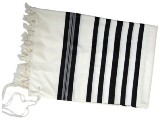 Turkish talleisim, which have always been considered the most kosher for being made of pure unadulterated sheep wool have, upon recent examination, found to sometimes have other woven materials, including linen, which would disqualify its exalted status and possibly be in violation of the Biblical Shatnez injunctions. This bad news represented a major hurdle for Belzer and Skverer Chassidim who use only Turkish talleisim.
Turkish talleisim, which have always been considered the most kosher for being made of pure unadulterated sheep wool have, upon recent examination, found to sometimes have other woven materials, including linen, which would disqualify its exalted status and possibly be in violation of the Biblical Shatnez injunctions. This bad news represented a major hurdle for Belzer and Skverer Chassidim who use only Turkish talleisim.
In the Aseres Y’mei Teshuvah 2008-5769, a member of the Skverer community in Spring Valley brought his two Turkish talleisim for testing at the Shatnez laboratory in Kiryas Yoel. Rabbi Doniel Steinberg, a member of the Kiryas Yoel Kollel and author of Peos K’Halachah, as director of the laboratory was shocked to discover that the Turkish tallis in front of him had fibers other than pure wool.
Rabbi Steinberg found recycled fibers woven into the full length of the tallis. The second tallis had polyester fibers woven into its width. The recycled fibers are an unknown.
The findings were unnerving. Though fibers woven into the wool of a tallis do not make it prohibited, nevertheless, if foreign fibers are found in supposedly pure wool Turkish tallis cloth, linen too may soon find its way into the wool. That is explicitly forbidden. Further, the foreign fibers cast doubt, though a small doubt, but, nevertheless, a doubt, as to the propriety of making a brachah on the tallis and fulfilling the mitzvah of Arba Kanfos.
Rabbi Steinberg immediately contacted Rabbi Aaron Goldminzer, Yoshev Rosh Vaad HaKashrus of Skver. He immediately required that all Turkish talleisim, the only ones Skverer Chassidim use, be tested before going on sale in Skver. Fifty brand new Turkish talleisim were then tested, 25 from each of Skver’s two religious artifacts stores. Polyester fibers were found in the talleisim. Since Sukkos, every new Turkish tallis was tested.
Last week, 40 new Turkish talleisim destined for the Skver community in Spring Valley were brought to the Shatnez laboratory in Kiryas Yoel. Shockingly, linen threads were found, thus disqualifying the talleisim. The threads were found in middle of the talleisim and needed extra testing.
After notifying Rabbi Goldminzer, both rabbis met with Rabbi Avrohom Zvi Wozner, Monsey Satmar Rav, who proceeded with caution. One Turkish tallis after another was checked and double-checked. The 14th thread was found to have 50% wool and the other 50% consisted of linen and silk, which constitutes Shatnez. Rabbi Wozner insisted that the talleisim also be tested at the Lee Avenue Shatnez Laboratory.
Shatnez Testing Laboratories Today
Rabbi Yosef Rosenberger, zt”l (d. 1996), established the first facility for Shatnez testing in America, on Lee Avenue in Williamsburg, in 1941. That facility created a network of Shatnez testers in established religious neighborhoods in the Greater New York City Metropolitan Area.
In addition, the Lakewood Shatnez Laboratories began a second network of more than 150 Shatnez testing facilities throughout the Northeast. They all trade information with each other and any interested parties. The Kiryas Yoel Shatnez Laboratory is part of the Lakewood network.
Recently, a special beis din was established to deal with Shatnez issues. Also, the Hisachdus HaRabbonim established a board of rabbis for Shatnez, headed by Rabbi Meshulem Polatchek, author of Meged Yehuda.
Checking With The Other Shatnez Network
Talleisim were forwarded to Rabbi Kreitman of the Monsey branch of Lee Avenue Shatnez Laboratories. At that time, Rabbi Yitzchok Bluestein, son-in-law of Rabbi Yosef Rosenberger, zt”l, was in Monsey to participate in the testing. Additional samples were forwarded to the Lee Avenue Laboratory in Williamsburg for testing by Rabbi Shlomo Fischer, a noted Shatnez expert.
Friday afternoon, Erev Shabbos Parshas Yisro, February 13, every tester confirmed that indeed linen had been found in the Turkish talleisim. This news put Belzer and Skverer Chassidim in a great dilemma. What to do? A Shatnez tallis is definitely not usable for the mitzvah of tzitzis, nor can it be worn or carried on Shabbos, and it is Muktzah – literally untouchable on Shabbos!
Should everyone in Belzer and Skverer shuls daven without talleisim? Should weekday ordinary talleisim of other communities be brought by Chaverim organization members and lent to Belzer and Skverer Chassidism for Shabbos? Since sundown that Friday was at 5:29:31 p.m., not enough of the day was left to undertake any of the contemplated actions.
The Monsey Satmar Rav, Rabbi Goldmine, and Rabbi Tuvia Wettenstein, Monsey Belzer Dayan quickly deliberated and allowed that for Shabbos (Yisro), the talleisim may be used but must be checked afterwards. Shabbos morning, many Monsey residents brought their talleisim to Rabbi Wozner who had acquired the ability to visually identify whether a Turkish tallis had foreign threads.
The Skverer Rebbe
That Friday Rabbi Dovid Twersky, Skverer Rebbe, quickly had his tallis checked and was gratified to learn that it was of pure wool. The Rebbe decided that from now on, it is preferable to use an ordinary checked tallis rather than an unchecked Turkish tallis. The Skverer Rebbe wore a KMO (similar to) Turkish tallis that Shabbos. The KMO Turkish talleisim are made of Turkish wool and are tested and generally processed in Israel. They have always maintained their status of unquestionable kashrus.
After many examinations and tests, determination was made that only one of several Turkish talleisim designs manufactured in the last three years required examination. Further, after exhaustive inquiries into the manufacture of Turkish talleisim once the overwhelming bulk of Jews left Tunisia, the sewing of talleisim by non-Jews without supervision automatically required that the talleisim be checked for Shatnez.
Testing, Testing, Testing
On February 15, Belzer and Skverer Chassidim of Monsey brought their talleisim for testing. They patiently waited in long lines to have their holy objects tested to see if they were kosher and usable. In Boro Park too, Belzer, Skverer and Rachmestrivka Chassidim brought their talleisim for testing.
On February 17, a Psak Din was declared. KMO Turkish talleisim have no Shatnez and all Echt Turkish talleisim must be checked, regardless of design or date of purchase.
A Turkish Tallis Really Comes From Tunisia
For centuries, stringent pious Jews have strived to use only Turkish talleisim, almost to the exclusion of all others, often referred to as an “Echt (genuine) Turkish Tallis.” In actuality, the tallis we know as “Turkish” comes from Tunisia, which was under the rule of the Ottoman Empire of Turkey from 1569 to 1922, and continued under Turkish influence until 1957, when the Tunisian Republic was declared. Tunisia has had a Jewish minority since Roman times.
In 1948, the Jewish population there was estimated at 105,000, but by 1967 most Tunisian Jews had left the country for France and Israel, and the Jewish population had declined to 20,000. As of 2004 an estimated 1,500 Jews still remain, particularly on the island of Djerba (noted for its synagogues), comprising Tunisia’s largest indigenous religious minority.
As long as a substantial Jewish population existed in Tunisia, Jews provided the much-preferred Turkish talleisim and their continued status as being of pure unadulterated wool continued. However, once the great majority of Tunisian Jews left, tallis dealers developed business relationships with non-Jews who continued the supply of Turkish talleisim
In Seforim
Rabbi Moshe Zvi Landau, zt”l, Kleinverdan Dayan (1905), in his sefer Shulchan
Melachim (1931), quotes Rabbi Sholom Rokeach, zt”l (1783 1855), founding
Belzer Rebbe and known as the Sar Sholom, as the reason that Tunisia does not have any flax plants is due to its aversion by a former ruler. Rabbi Moshe Yehuda Katz, zt”l, author of Vayaged Moshe quotes the Sar Sholom as saying that when Beis HaMikdash was destroyed, the virtues of Eretz Yisroel were distributed to the nations. The virtue of exalted wool was given to Tunisia.
Sefer Gedulas Yehoshua (Volume 8, page 73) quotes Rabbi Chaim Zvi Teitelbaum, zt”l (1880-1926), Sigeter Rav and author of Atzei Chaim, as saying that the wool from Tunisia was the important element, not that it necessarily had to be woven in Tunisia.
However, a sefer, which includes a compendium of quotes and rulings of Rabbi Moshe Aryeh Freund, zt”l (1903-1996), Yerushalayimer Rav, notes Rabbi Freund’s hearing from Rabbi Sholom Eliezer Halberstam, Hy”d (1862 1944), Ratzferter Rebbe and son of Rabbi Chaim Halberstam, zt”l (1797 1876), revered Sanzer Rebbe and author of Divrei Chaim, that, indeed, the webbing too must be in Tunisia to preserve its status.
The sefer also quotes Rabbi Fruend as citing Rabbi Yechezkel Shraga Halberstam, zt”l (1813-1898), Shiniva Rebbe and author of Divrei Yechezkel, son of the Divrei Chaim, as having been in Tunisia to certify that no flax was cultivated there.
Sefer Taam Zvi notes the description in the Kitzur Shulchan Aruch (9:8) of wrapping oneself in a tallis similar to Yishma’elim as a direct reference to talleisim coming from Tunisia. The Taam Zvi explains why Rabbi Zvi Hirsh Eichenstein, zt”l (1763-1831), revered Zidichover Rebbe and author of Ateres Zvi, wore a Turkish tallis only during the weekdays.
On Shabbos, he wore an ordinary tallis manufactured in Kolomai under strict supervision. The Ateres Zvi explained that the Turkish tallis had a great holiness, which he needed to compensate for the lower degree of holiness of the weekdays. However on Shabbos, which has a great degree of holiness, the plain Kolomai tallis suffices. The Taam Zvi negatively describes those who, should they not have a Turkish tallis, would rather not use another type of tallis at all.
Rabbi Chaim Yosef David Azulai, zt”l (1724-1806), the Chidah, in his Birkei Yosef on Hilchos Kelayim (Yoreh De’ah 299), praises the Chassidim who wear silk bekeshes (frocks) so as to avoid wearing wool, fearing the possibility of wearing wool garments that may have linen threads in it.
Blue And White, Black And White
Interestingly, in generations past, Turkish talleisim were known to be blue and white, as opposed to today’s black and white. The blue, presumably, was a remembrance to the techeles (blue wool) that is described in Bamidbar -Shelach 15:38. Today we no longer have certainty in regard to the exact source of techeles; therefore, the Turkish tallis was blue and white as a reminder of the techeles.
With the establishment of the State of Israel and the eclipsing selection of blue and white as its flag, with its stripes and Magen David, the Turkish tallis evolved into black and white to differentiate it from Israel’s proud flag.
{Machberes-Rabbi Gershon Tannenbaum/Matzav.com Newscenter}












R’ Yaakov Kreitman AKA Monsey Shatnez Test Center certified by BAIS-DIN-MISPAT-SHOLOM, declared that the fibers are NOT linen.
Why didn’t the BELZ & SKVER Rabonim go with that “Bais-Din’s” Psak. They went to the Testers that are certified by the International Shatnez Testers (Lakewood) who declared that some are indeed Shatnez & others are mixed fibers.
After all why can’t we rely on BAIS-DIN MISHPAT SHOLOM?